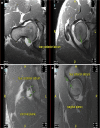Arthroscopic anterior and posterior labral repair after traumatic hip dislocation: case report and review of the literature
- PMID: 21886540
- PMCID: PMC2926365
- DOI: 10.1007/s11420-010-9156-1
Arthroscopic anterior and posterior labral repair after traumatic hip dislocation: case report and review of the literature
Abstract
With the improvements in flexible instrumentation, hip arthroscopy is being increasingly used to treat a variety of hip pathology, including labral tears. However, up to this point, there has not been a case report of an anterior and a posterior labral tear successfully repaired arthroscopically. We present a case report of a 27-year-old male firefighter who presented to our institution with an anterior and posterior labral tear, as well as a cam lesion and loose body, following a traumatic hip dislocation. The purpose of this case report is to illustrate that both anterior and posterior labral tears can be repaired using hip arthroscopy. Anterior and posterior labral tears can be caused by a traumatic hip dislocation, and both can be successfully repaired using arthroscopic techniques.
Keywords: anterior; arthroscopy repair; hip; labral tear; posterior; traumatic dislocation.
Figures





Similar articles
-
Comprehensive Evaluation and Arthroscopic Management of Circumferential Labral Tears Following Traumatic First Time Shoulder Dislocation: A Case Report and Review.J Orthop Case Rep. 2024 Jun;14(6):125-129. doi: 10.13107/jocr.2024.v14.i06.4526. J Orthop Case Rep. 2024. PMID: 38911003 Free PMC article.
-
Traumatic shoulder instability involving anterior, inferior, and posterior labral injury: a prospective clinical evaluation of arthroscopic repair of 270° labral tears.Am J Sports Med. 2011 Aug;39(8):1687-96. doi: 10.1177/0363546511405449. Epub 2011 May 12. Am J Sports Med. 2011. PMID: 21566068 Clinical Trial.
-
Arthroscopic Treatment of a Posterior Labral Interposition after a Pediatric Hip Dislocation-A Case Report.European J Pediatr Surg Rep. 2018 Jan;6(1):e43-e47. doi: 10.1055/s-0038-1661408. Epub 2018 Jul 13. European J Pediatr Surg Rep. 2018. PMID: 30013888 Free PMC article.
-
Arthroscopy After Traumatic Hip Dislocation: A Systematic Review of Intra-articular Findings, Correlation With Magnetic Resonance Imaging and Computed Tomography, Treatments, and Outcomes.Arthroscopy. 2018 Mar;34(3):917-927. doi: 10.1016/j.arthro.2017.08.295. Epub 2017 Nov 13. Arthroscopy. 2018. PMID: 29146169
-
Labral tears, extra-articular injuries, and hip arthroscopy in the athlete.Clin Sports Med. 2006 Apr;25(2):279-92, ix. doi: 10.1016/j.csm.2006.01.003. Clin Sports Med. 2006. PMID: 16638491 Review.
Cited by
-
[Arthroscopic treatment of irreducible hip posterior dislocation caused by acetabular labrum bony Bankart lesions].Zhongguo Xiu Fu Chong Jian Wai Ke Za Zhi. 2019 Jun 15;33(6):676-680. doi: 10.7507/1002-1892.201901059. Zhongguo Xiu Fu Chong Jian Wai Ke Za Zhi. 2019. PMID: 31197992 Free PMC article. Chinese.
-
The recognition and evaluation of patterns of compensatory injury in patients with mechanical hip pain.Sports Health. 2014 Mar;6(2):108-18. doi: 10.1177/1941738114522201. Sports Health. 2014. PMID: 24587859 Free PMC article.
References
-
- Chudik S, Lopez V. Hip dislocations in athletes. Sports Med Arthrosc Rev. 2002;10:123–133. doi: 10.1097/00132585-200210020-00004. - DOI
-
- Kelly BT, Williams RJ, III, Philippon MJ. Hip arthroscopy: current indications, treatment options, and management issues. Am J Sports Med. 2003;31(6):1020–1037. - PubMed
Publication types
LinkOut - more resources
Full Text Sources

